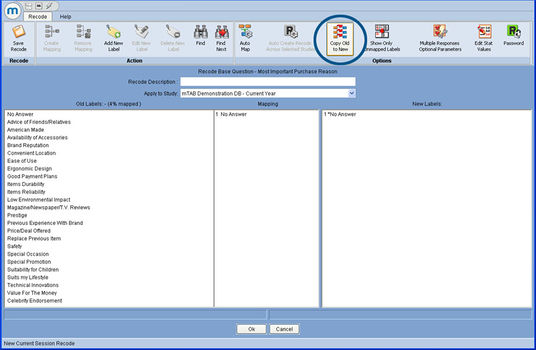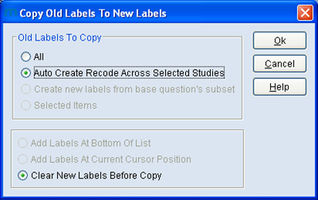Auto create recode across selected studies
When working with survey data, one of the toughest challenges is trending it across time. Many aspects of a survey can change as time goes by and, thus, matching one year’s responses with another is difficult.
mTAB offered the Recode function to simplify this challenge, which allows the user to connect together response tables from multiple years of data.
However, this has still required a number of steps and so we have looked to make the process even easier through the addition of a new feature named "Auto Create Recode Across Selected Studies".
Begin by selecting the studies that you are attempting to trend in your Layer panel and then locating the question that you wish to trend. By right-clicking on the question, select Recode from the menu and the Recode Editor will appear. Alternatively, you can select the question you wish to trend and click on the Recode icon in the Question ribbon. The Recode Editor lists the responses for the currently displayed year on the left in the Old Labels panel.
Next, select the Copy Old to New icon at the top of the Recode Editor and this will bring up this dialog.
On this dialog you will see the "Auto Create Recode Across Selected Studies" radio button. Selecting this option and then clicking OK will start the process.
What this does is it begins with the Primary Study and copies all of the responses from that year across as New Labels. It will then work its way back across the other years currently selected in the Layer panel and it will find any common responses and connect them together for each study. For any responses that exist in the secondary studies and not in the Primary study, mTAB will add them to the New Labels column as well and map them accordingly.
The only decision you are faced with is whether you would like the resulting set of New Labels (responses) sorted alphabetically or not, which is presented to you as a dialog.
Selecting Yes will mean that the responses to the finished recode will be automatically sorted in alphabetical order and all you will need to do is to save the recode and it is ready for use. Should you select No, then any responses that exist in the secondary studies and not in the Primary study will appear together in the New Labels section at the top. This will mean that once the automated process is complete, it will be up to you to then re-order those responses as you see fit. Once the labels are in the desired order, all you will need to do is to save the recode and it will be ready for use.


